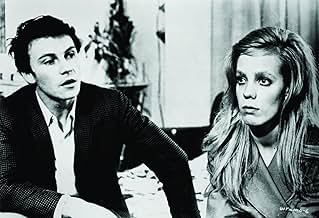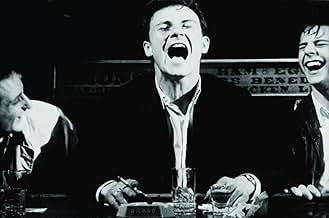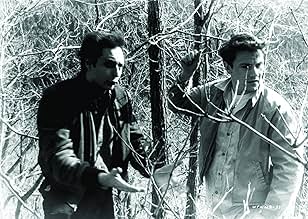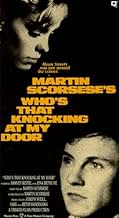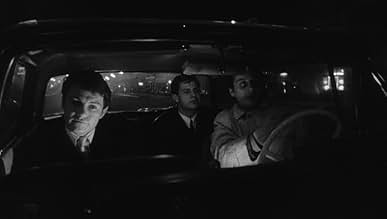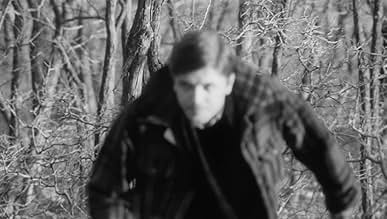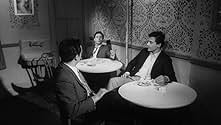NOTE IMDb
6,5/10
11 k
MA NOTE
Un jeune homme se débat avec le fait que sa petite amie a été victime d'un viol.Un jeune homme se débat avec le fait que sa petite amie a été victime d'un viol.Un jeune homme se débat avec le fait que sa petite amie a été victime d'un viol.
- Réalisation
- Scénario
- Casting principal
- Récompenses
- 1 nomination au total
Anne Collette
- Girl in Dream
- (as Ann Collette)
Philip Carlson
- Boy in Copake
- (as Phil Carlson)
Marrissa Joffre
- Girl at Party
- (as Marrisa Joffrey)
Victor Magnotta
- Boy in Fight
- (as Vic Magnotta)
Thomas Aiello
- Minor Role
- (non crédité)
Avis à la une
Filmed over years apparently, this early M. Scorsese New York tale involving young dudes being typically out of it is interesting in the scenes with Keitel and the girl (Z. Bethune), but the buddy scenes tend to drag on and semi-bore. A 5 out of 10. Best performance = Zena Bethune.
Harvey Keitel has always been interesting and believable and it's great to see him in a lead (pre-MEAN STREETS) and Ms. Bethune is very touching and human. All Scorsese fans should track this down even though it's not that great. The DVD has a semi-commentary from Marty which is unusual! It comes in the recent DVD set of Martin Scorsese and worth a look! Harry Northrup has a small role (MEAN STREETS, TAXI DRIVER).
Harvey Keitel has always been interesting and believable and it's great to see him in a lead (pre-MEAN STREETS) and Ms. Bethune is very touching and human. All Scorsese fans should track this down even though it's not that great. The DVD has a semi-commentary from Marty which is unusual! It comes in the recent DVD set of Martin Scorsese and worth a look! Harry Northrup has a small role (MEAN STREETS, TAXI DRIVER).
This is a hard movie to review because it's essentially an amalgam of several different shorter student films, and some work better than others.
That said, at the crux of "Who's That Knocking at My Door" (the final mass-released version) is a complex character-study laden with Catholic guilt and burdened by all the inherent stigmas and traditions of growing up Italian-American.
Obviously Scorsece knew his source material very well. More than half of the players and virtually all the locations come straight from his own life. What's really cool about the film, though, is how honestly he portrays these sociological nuances. He doesn't tell you Keitel's character's views and attitudes are good or bad, they just "are" --- and it's obvious how the character developed them from a peek into his everyday world.
This bracing honesty is the most appealing thing about the film, along with some drop-dead gorgeous camera work and editing featured here. The first scene where Keitel meets Bethune on the ferry has got to be one of the most imaginatively-shot and enthrallingly staged boy-meets-girl moments on celluloid. Throughout the film, Scorcese overlays soundless scenes from the past and future, creating interesting juxtapositions, always engaging and challenging your perceptions.
With a lot of debuts there are missteps. I don't think that fairly characterizes this movie however. There are definitely parts that drag and don't work well but seen in the context of a shorter film, they would have been more effective. As they're all blended together here, the pacing sometimes suffers.
It's hard to imagine any of the fans of Scorsece's later works, which rely so heavily on hyper-real camera-work and tightly-structured story lines, to have the patience for "Who's That Knocking." But for those who really enjoy the thoughtfulness, subversiveness, and subtext of Scorcese's films, it's a treat to see their origins so prominently displayed.
That said, at the crux of "Who's That Knocking at My Door" (the final mass-released version) is a complex character-study laden with Catholic guilt and burdened by all the inherent stigmas and traditions of growing up Italian-American.
Obviously Scorsece knew his source material very well. More than half of the players and virtually all the locations come straight from his own life. What's really cool about the film, though, is how honestly he portrays these sociological nuances. He doesn't tell you Keitel's character's views and attitudes are good or bad, they just "are" --- and it's obvious how the character developed them from a peek into his everyday world.
This bracing honesty is the most appealing thing about the film, along with some drop-dead gorgeous camera work and editing featured here. The first scene where Keitel meets Bethune on the ferry has got to be one of the most imaginatively-shot and enthrallingly staged boy-meets-girl moments on celluloid. Throughout the film, Scorcese overlays soundless scenes from the past and future, creating interesting juxtapositions, always engaging and challenging your perceptions.
With a lot of debuts there are missteps. I don't think that fairly characterizes this movie however. There are definitely parts that drag and don't work well but seen in the context of a shorter film, they would have been more effective. As they're all blended together here, the pacing sometimes suffers.
It's hard to imagine any of the fans of Scorsece's later works, which rely so heavily on hyper-real camera-work and tightly-structured story lines, to have the patience for "Who's That Knocking." But for those who really enjoy the thoughtfulness, subversiveness, and subtext of Scorcese's films, it's a treat to see their origins so prominently displayed.
"Who's That Knocking At My Door?" (1968) is the kind of film where you see it once you'll want to see it again, just to see what you didn't understand. The protagonist is played by Harvey Keitel as J.R., an autobiographical role based loosely on Scorsese's strict Catholic upbringing. And many symbolic Catholic references there are such as the Virgin Mary mini statue reflection in the mirror watching Harvey Keitel's JR as he embraces "The Young Girl" played by Zina Bethune.
Scorsese is so intelligent and inventive with his scenes here; crafty artsiness at its best (like the one where J.R. is having sex with the "broad" in a dream fantasy, but then afterwards flips his cards towards her rejecting her as a sin; she's not a nice virgin who would be a good wife and mother for J.R.; she's just a whore, a "broad", as we listen to The Doors' song 'The End' finish). Marty's own personal style was established in this early film.
Harvey Keitel was 29-years-old when Martin Scorsese's [who was 25] "Who's That Knocking At My Door?" debuted in 1968. This was a full-length feature debut for both actor Keitel and director Scorsese. It was interesting to see this for the first time recently after I had already seen most of Scorsese's later films. His classic trade marks such as the "freeze frame, slow-motion, and classic rock tracks playing on the soundtrack" are all utilized effectively in this early gem. ("Easy Rider" is always the film that is credited as being the originator of playing classic rock tunes on the soundtrack, but "Who's That Knocking At My Door?" wasn't seen by many until it received wide release in 1970, almost three years after it was made.)
For any film school student or aspiring director/screenwriter this is a must see. Mr. Scorsese financed this film on a tight budget. I read somewhere that his film professor from NYU helped him finance it. From the beginning somebody somewhere knew Marty had the talent and could make a good picture. He created a wonderful film; using his own life experience for the story he was able to concoct a great, interesting and personal film. His "Mean Streets" (1973) is a much greater and even more personal film. But "Who's That Knocking At My Door?" was the beginning.
I'm not Catholic but I certainly learn a lot about Catholicism when I watch a Scorsese flick. For instance, take the scene where "The Young Girl" is making dinner at J.R.'s place, she lights up what appears to be just a candle. But to J.R. it is a "Holy Candle" and makes her put it back and replace it with another one. There are many classic scenes in this film, but I don't want to spoil it for you.
Directed by Martin Scorsese. Edited By Thelma Schoonmaker (who would go on to edit almost all of Scorsese's later films). Starring Harvey Keitel as J.R. 90 minutes.
Scorsese is so intelligent and inventive with his scenes here; crafty artsiness at its best (like the one where J.R. is having sex with the "broad" in a dream fantasy, but then afterwards flips his cards towards her rejecting her as a sin; she's not a nice virgin who would be a good wife and mother for J.R.; she's just a whore, a "broad", as we listen to The Doors' song 'The End' finish). Marty's own personal style was established in this early film.
Harvey Keitel was 29-years-old when Martin Scorsese's [who was 25] "Who's That Knocking At My Door?" debuted in 1968. This was a full-length feature debut for both actor Keitel and director Scorsese. It was interesting to see this for the first time recently after I had already seen most of Scorsese's later films. His classic trade marks such as the "freeze frame, slow-motion, and classic rock tracks playing on the soundtrack" are all utilized effectively in this early gem. ("Easy Rider" is always the film that is credited as being the originator of playing classic rock tunes on the soundtrack, but "Who's That Knocking At My Door?" wasn't seen by many until it received wide release in 1970, almost three years after it was made.)
For any film school student or aspiring director/screenwriter this is a must see. Mr. Scorsese financed this film on a tight budget. I read somewhere that his film professor from NYU helped him finance it. From the beginning somebody somewhere knew Marty had the talent and could make a good picture. He created a wonderful film; using his own life experience for the story he was able to concoct a great, interesting and personal film. His "Mean Streets" (1973) is a much greater and even more personal film. But "Who's That Knocking At My Door?" was the beginning.
I'm not Catholic but I certainly learn a lot about Catholicism when I watch a Scorsese flick. For instance, take the scene where "The Young Girl" is making dinner at J.R.'s place, she lights up what appears to be just a candle. But to J.R. it is a "Holy Candle" and makes her put it back and replace it with another one. There are many classic scenes in this film, but I don't want to spoil it for you.
Directed by Martin Scorsese. Edited By Thelma Schoonmaker (who would go on to edit almost all of Scorsese's later films). Starring Harvey Keitel as J.R. 90 minutes.
"Who's that knocking at my door" is along with "Boxcar Bertha" the most unknown picture of the Italian-American genius Scorsese. Make no mistakes: it's nothing like a masterpiece and it's no surprise that almost no one know about this movie, but here we got some of the constants in Marty's cinema: the street talking, the violence, the outsiders... Those things that "mean streets" dealt about... This was Martin Scorsese's debut and so it was for his friend Harvey Keytel who plays a chauvinist-bad tempered young man.
So, this is a movie that I recommend to those who really love Scorsese's work and wanna know about his origins.
*My rate: 6/10
So, this is a movie that I recommend to those who really love Scorsese's work and wanna know about his origins.
*My rate: 6/10
Here is Martin Scorsese's first feature film, and already, at a mere 25 years old in 1967, it is clear this young man had the determination and eye for visceral images, solid acting and a great ear for soundtracks. A rather raw and unpolished work, Who's That Knocking at My Door works in other ways such as the professionally-done editing by the great Thelma Schoonmaker, another future Scorsese collaborator. In the lead role is a very young Harvey Keitel, who plays the role of a young New York Italian very similar to the nature and style of Martin Scorsese himself. Clearly, there was a special bond between these two that continued for years.
The plot, while at times veering wildly off track, focuses on a young couple attempting to overcome a difficult instance in the past that still looms over the future. With numerous Catholic images and references, this is one of the more explicitly religious of Scorsese's work but there is still a definitive drive behind everything. It is certainly worth watching for anyone who is interested in making their own film as well as any fan of Scorsese eager to know how he got to where he is today. Not always great, sometimes very powerful, this film still remains a strong piece of work that encompasses much of future themes Scorsese would come back to: Catholic guilt, relationships between street friends and the difficulties of romance.
The plot, while at times veering wildly off track, focuses on a young couple attempting to overcome a difficult instance in the past that still looms over the future. With numerous Catholic images and references, this is one of the more explicitly religious of Scorsese's work but there is still a definitive drive behind everything. It is certainly worth watching for anyone who is interested in making their own film as well as any fan of Scorsese eager to know how he got to where he is today. Not always great, sometimes very powerful, this film still remains a strong piece of work that encompasses much of future themes Scorsese would come back to: Catholic guilt, relationships between street friends and the difficulties of romance.
What Scorsese Film Ranks Highest on IMDb?
What Scorsese Film Ranks Highest on IMDb?
Cinema legend Martin Scorsese has directed some of the most acclaimed films of all time. See how IMDb users rank all of his feature films as director.
Le saviez-vous
- AnecdotesIn order to get distribution for his film, Martin Scorsese was told to add nude scenes so it could be promoted as a "sexploitation" movie. He thus shot the fantasy scene showing J.R. imagining encounters with prostitutes.
- GaffesMartin Scorsese utilizes the black and white nature of film to hide the lack of time and day continuity in some scenes.
- Crédits fousThere is a big "Thanks to the County and City of New York" in the end credits.
- Versions alternativesEarly versions of this film were screened without the erotic fantasy scene.
- ConnexionsFeatured in Une décennie sous influence (2003)
- Bandes originalesJenny Take a Ride
(uncredited)
Written by Bob Crewe, Enotris Johnson, and Little Richard
Performed by Mitch Ryder & The Detroit Wheels
Meilleurs choix
Connectez-vous pour évaluer et suivre la liste de favoris afin de recevoir des recommandations personnalisées
Détails
- Date de sortie
- Pays d’origine
- Sites officiels
- Langue
- Aussi connu sous le nom de
- Bring on the Dancing Girls
- Lieux de tournage
- Amsterdam, Noord-Holland, Pays-Bas(as New York, only interior, scenes with nudity)
- Sociétés de production
- Voir plus de crédits d'entreprise sur IMDbPro
Box-office
- Budget
- 75 000 $US (estimé)
- Montant brut mondial
- 16 085 $US
- Durée1 heure 30 minutes
- Couleur
- Mixage
- Rapport de forme
- 1.85 : 1
Contribuer à cette page
Suggérer une modification ou ajouter du contenu manquant

Lacune principale
By what name was Who's That Knocking at My Door (1967) officially released in India in Hindi?
Répondre
